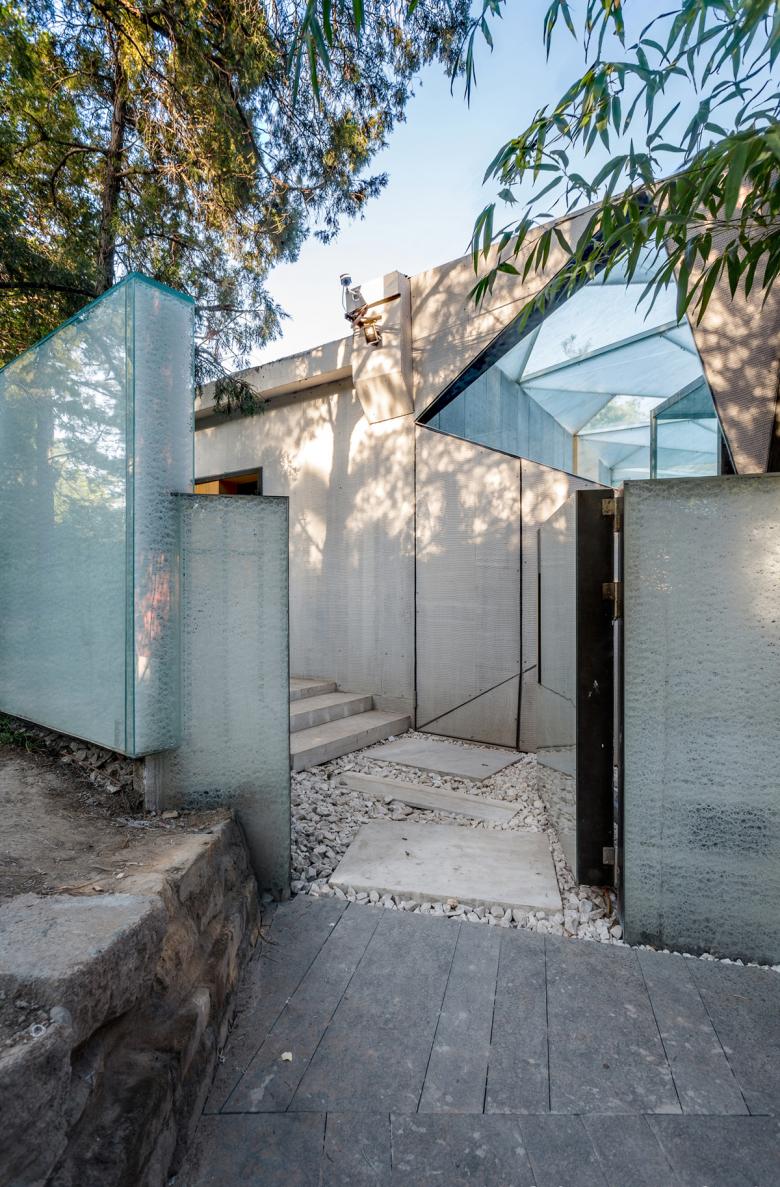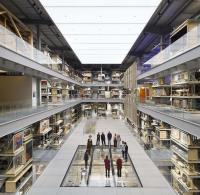The Forbbiden City Red-Wall Teahouse
Beijing, China
The Red-wall Teahouse is situated inside a public park which used to be the Ancestral Temple – a royal memorial temple for ancestors southeast to the Forbidden City. The palace wall on the east side of the temple wrapped around the Forbidden City as the second ring wall in which Tian’an Men functioned as the main gate. The wall had long been a symbol of social class division in old China, now nothing but a spatial threshold separating the imperial garden from the Hutong houses to the east. During modern authority transitions, undocumented damage took down northern half of the wall.
The renovation project took place right at the breakage of the wall. Two shabby warehouses were left on site unattended, one attached to the red imperial wall and the other one set around three meters away north to the first one. As an immediate design reaction, the roof of the first warehouse was tipped down to reveal the body of the palace wall on the Hutong side. Then a cluster of freestanding steel-frame tearooms were inserted into the middle of the ‘unroofed garden’ introducing courtyards in between the old and the new structures. The exterior of the north teahouse which had been kept in better shape was insulated with new cover material. Its interior was opened up to match modern program needs. It is, then, through such interplay of old and new, volume and void, tradition and modern, solemnity and absurdness that unprecedented readings on local environment start to emerge.
City behaves like a giant organ. Abundant boundary spaces, gaps and buffer areas among buildings and urban spaces are locations most likely to grow and decline. On one hand, they deteriorate as insufficient maintenance is carried out. On another, opportunities find their way to flourish and prosper in their own rights.
The Forbidden City,once as an iconic imagery of royal authority,displays clear separation from the Hutong houses beyond. The height, massiveness and solidity of its palace wall were a powerful demonstration of this absolute threshold. As the class-based feudalism turned into ashes in the last century, what was left of the royal garden was converted into a giant museum allowing unrestricted entrance for the public. As long as the loss of social hierarchy, Hutong space had extended outwards paying no respect for the ancient. As a result, worn warehouses were built attached to the palace wall regardless of any sense of integrity. This unique spot of the city, full of uncertainty, became ever blurry and twisted.
Narrow and closeness was the main challenge of the project. Within the limited space, it is, first of all, essential to meet the program needs of the owner’s while, and at the same time, addressing the heritage environment on the inner side of the palace wall and living conditions of the Hutong dwellers on the other side. To balance individual privacy while sharing open landscape, to establish new built environment while preserving historical legacy were our fundamental tasks. It was also important that we took critical stands against those who falsifies tradition by mimicking an imagery of old Chinese teahouse or those who superimpose arbitrary modern forms over historical heritage. We believe a genuine design with adequate self-retrospection on the weight of history will sustain a smooth life full of small delightful moments.
The owner asked for a quite office space for receiving business partners over tea time. Seven unique rooms,ranging from three to twenty square meters cluster in the middle of courtyards and gardens displaying various shapes, enclosure and finish materials. Lighting and furnishing is designed to correspond to the shifting room scales. In the end, the set of spaces start to enliven the once obstructed environment turning into a contributing part of the new built environment.
As the medium,landscape helps to integrated previously separated royal garden, palace wall and Hutong space become organic parts of the overall coherent environment. Transition from one side to the other and from courtyard to interior is soft and blurry, through which history and modern collided and exchange. Through the landscape,we try to arouse visitors’ sensitivity. Occasional void enriches movement and lures the exploration into the depth of the space.
In the project we experimented with a variety of materials, which seemed to have made a small joke on so called ‘minimalism’. There are natural materials like stone, bamboo and wood, semi-synthetic materials like steel sheet, copper and brick and synthetic materials like glass, polycarbonate board, cement board etc. Dark red paint and yellow encaustic tiles of the palace wall and gray tiles on the pitch roofs of the Hutong houses also exerted influence on the materiality consideration of the project. We exploited uncommon ways of using materials under the determination to extend their potentials for giving delicate sensations to the special place, just like how we rediscover the ancient palace wall in complete modern setting with fresh perspectives.
INFORMATION
Project name: The Forbidden City Red-wall Teahouse
Location: the Ancestral Temple, the Forbidden City, Beijing, China
Architects in charge: ZHANG Hetian, ZHANG Hong
Floor Area: 280m2
Photography: CHEN Su, WANG Yi, ZHANG Hetian
Year: 2012-2014
Completion Date: 2014





























